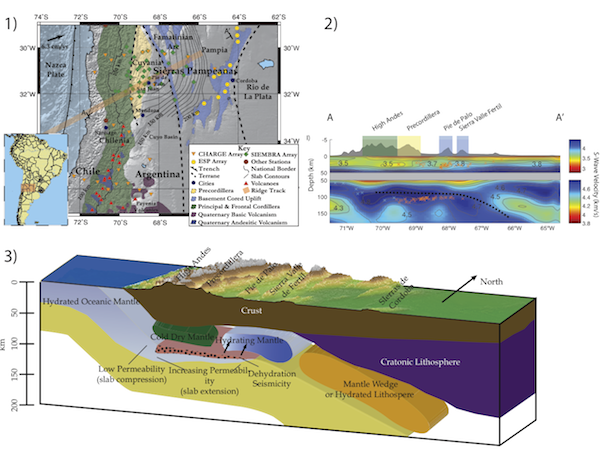2012 IRIS Workshop
Shear-Wave Velocities in the Pampean Flat-Slab Region from Rayleigh Wave Tomography: Implications for Slab and Upper Mantle Hydration
Ryan Porter: Department of Geosciences, The University of Arizona, Hersh Gilbert: Department of Earth & Atmospheric Sciences, Purdue University, George Zandt: Department of Geosciences, The University
A) Location map showing the Pampean Flat Slab region located in central Argentina and Chile. 2) Cross section of Sv velocities calculated from earthquake-generated and ambient-noise Rayleigh wave tomography. Location is shown in panel 1). Dashed line is the top of the slab based on earthquake locations and receiver function data. Orange and blue x’s are earthquake locations. 3) Interpretation of shear velocities.

Full-resolution graphics file in original format: 0053.ai
The Pampean flat-slab region, located in central Argentina and Chile between 29° and 34° S, is considered a modern analogue for Laramide flat-slab subduction within western North America. Regionally, flat-slab subduction is characterized by the Nazca slab descending to ~100 km depth, flattening out for ~300 km laterally before resuming a more “normal” angle of subduction. Flat-slab subduction correlates spatially with the track of the Juan Fernandez Ridge, and is associated with the inboard migration of deformation and the cessation of volcanism within the region. To better understand flat-slab subduction we combine ambient-noise tomography and earthquake-generated surface wave measurements to calculate a regional 3D shear velocity model for the region. Shear-wave velocity variations largely relate to changes in lithology within the crust, with basins and bedrock exposures clearly defined as low- and high-velocity regions, respectively. We argue that subduction related hydration plays a significant role in controlling shear-wave velocities within the upper mantle. In the area of normal-angle subduction zone in the southern part of the study area, the slab is visible as a high-velocity body with a low-velocity mantle wedge above it, extending eastward from the active arc. Where flat-slab subduction is occurring, slab velocities increase to the east while velocities in the overlying lithosphere decrease, consistent with the slab dewatering and gradually hydrating the overlying mantle. The hydration of the slab may be contributing to the excess buoyancy of the subducting oceanic lithosphere, helping to drive flat-slab subduction.
Acknoweldgements: We acknowledge the support of IRIS and the PASSCAL Instrument Center for their assistance with the SIEMBRA, CHARGE and ESP seismic deployments. The seismic instruments for CHARGE and SEIMBRA were provided by the PASSCAL Instrument Center (NSF Cooperative Agreement EAR-0552316). We also appreciate the assistance provided by the Instituto Nacional de Prevencion Sosmica, Argentina. This research was supported by the NSF (EAR-0510966, EAR-0738935, EAR-0739001 and EAR-0651540).
Keywords: subduction, ambient_noise, surface_waves, south_america
